
Jump to the quick list↴
1. Best overall: Squarespace
2. Best beginner: Jimdo
3. Best value: Wix
4. Best e-commerce: Shopify
5. Best for portfolios: Fabrik
6. For more control: Voog
7. Best WordPress: BlueHost
8. Best for AI: Hostinger
How to choose
How we test
FAQs
The best website builders for artists will help you show off your creative talents in all their glory, allowing you to make everything from a simple, aesthetically pleasing site to a more complex and sprawling catalog of creative projects.
We’ve put all of the best website builders below through their paces to see how well they’d perform for a wide variety of needs, considering features like online forms and e-commerce tools to SEO and marketing options, as well as the UI/UX of the builder itself. Of course, we also consider the end product and the value, too; all of this combined results in our top picks in the list below.
All of these builders offer clean design and simple e-commerce features, or you can find more options on our best web builders for small businesses or best website builders for photographers guides.
Quick list
 Best overall
Best overall
We think Squarespace is the best website builder for artists overall because of its beautiful minimalist templates. We found these super easy to customise for a professional look with no need to know code.
Read more below
 Best for beginners
Best for beginners
For a simple and sweet option that will suit beginners, Jimdo is a treat. Simply answer its short quiz and prompts, tweak the settings and voila, it’ll do the whole thing for you; no messy UI/UX needed.
Read more below
 Best value
Best value
We found that Wix makes building a site easy, even for someone with no experience required. There’s a 14-day free trial and the pricing is very reasonable after that. There’s even a free plan if you’re totally strapped for cash.
Read more below
The best website builder for artists overall
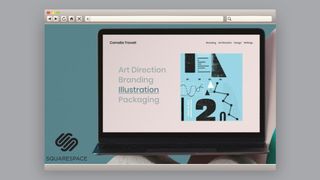

Specifications
Reasons to buy
Reasons to avoid
In theory, having your own website gives you ultimate control over how your work is presented online. However, if you lack design and coding skills, you’re limited to using the templates that are available. This means that the best website builder for artists will normally be one that has great-looking templates. For this criterion, Squarespace wins hands down, making it our top pick.
Aimed specifically at creatives such as artists, illustrators and photographers, Squarespace goes to great pains to allow you to present your portfolio in style. Its templates are crafted by professional designers, and they really are lovely. You don’t need to know anything about coding: just pick a template, then drag and drop your images and text into it.
Admittedly, in our tests, we didn’t find Squarespace’s interface the easiest to use: there’s a bit of a learning curve involved. But you do get helpful advice pop-ups wherever you hover your cursor, so we found it doesn’t take too long to get up to speed. Squarespace is also one of the more expensive web builders. But if you want a website that can really show your work at its best, we reckon it’s worth the extra cash. You also have the option of adding a blog or an online store to sell prints and other items. In theory, it could pay for itself and more over time.
There’s no free plan, but Squarespace does offer a 14-day free trial, with no credit card needed, so you won’t get charged accidentally by forgetting to cancel the trial. For more details, see our Squarespace review.
The best beginner website builder for artists
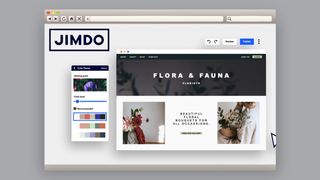
Specifications
Reasons to buy
Reasons to avoid
As we said earlier, you don’t need to understand code to use any of these website builders. But maybe you’re an artist who generally finds using computers and web technologies intimidating and difficult? If that’s the case, Jimdo is a great option when it comes to ease of use for beginners.
Anyone can use this website builder to get a site up and running: it really couldn’t get much simpler. Because you don’t actually have to build the site yourself: the system will automatically do it for you.
Here’s how it works. You start creating your site without committing any money or supplying a credit card – just choose the ‘free’ option when you get to the payment page. Then Jimdo will ask you a series of questions about what you want your website to do.
You can respond to (or skip) a series of prompts that makes it super-easy to do things like change the fonts and add your own images and text. This guided approach makes Jimdo great for those for whom even a template-driven platform like Squarespace is overwhelming. (Wix, number two on our list, offers a similar approach via its Wix ADI service).
We did find a few issues with Jimdo in our tests, though. Its templates are pretty basic and not exactly beautiful, which may be a deal breaker for artists. But if you want something quick and easy, that may be a compromise you’re willing to make. That said, Jimdo isn’t just for newbies. If you know how to code, you can install widgets that allow you to modify the HTML and CSS of the templates.
Jimdo lacks live chat or phone support, so if you get stuck, you have to fill in a form, which was a bit of a faff compared to the support other web builders offer. And you can’t expect the fastest response unless you’re on the most expensive plan, either. See our Jimdo review for more.
The best value website builder for artists

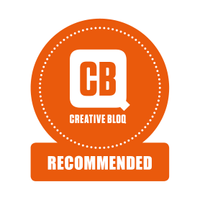
Specifications
Reasons to buy
Reasons to avoid
Though it’s not specifically aimed at creatives, Wix’s basic plan is well worth considering if you’re on a tight budget because it’s just such good value. Wix’s drag-and-drop editor offers more than 900 templates, and there are a lot of art-focused templates to choose from, including ones aimed at art photographers, illustrators, art galleries, and more.
For an even quicker approach, there’s Wix ADI, where you answer questions and the platform just designs a website for you (JimDo, number 2 on our list, offers a similar approach). We found this to be extremely quick and easy to use. Overall, we found the platform to be one of the most straightforward, thanks to the interface’s simple navigation: dragging and dropping elements and clicking to edit blocks just feels really intuitive, and there’s a refreshing absence of technical jargon to look up tutorials for.
We found the Wix app to be easy to use too. It echoes the desktop interface, so it takes no time to adapt, and while it’s a bit more awkward than editing on a desktop, it’s great to have an easy option to edit a site on the go. Best of all for those who aren’t ready to commit to a paid plan, Wix has a ‘Free forever’ option that will give you a basic website for no cost with 500MB storage (though your site will be plastered with ads and you’ll have a Wix-branded URL and limited storage and bandwidth.
To learn more, check out our more detailed Wix review.
The best ecommerce website builder for artists


Specifications
Reasons to buy
Reasons to avoid
If your main interest in having a website is to sell paintings, prints and other artworks directly to the public, we recommend Shopify. The website builder that’s most focused on creating e-stores, Shopify is fundamentally geared towards helping you become a successful online retailer, whether you’re selling other people’s products or your own.
Shopify has some nice-looking templates, we found the interface easy to use, and it offers all the e-commerce features you can shake a stick at. Be warned: unlike Squarespace or Wix, most of the templates aren’t free, and the service as a whole is on the pricey side. That said, if it helps you sell more, then that extra cost should be worth it in the long term.
The platform offers excellent technical support, its payment system works with a variety of providers, and you get a huge range of options for customising your store. Learn more in our Shopify review.
Best for portfolio websites
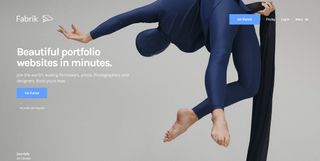
05. Fabrik
Specifications
Reasons to buy
Reasons to avoid
Fabrik is special in that you choose which creative discipline you’re showcasing, and its intelligent themes work accordingly to present your work optimally. This includes artists, but also photographers designers, 3D artists, illustrators, agencies and more. You upload your high-res images and the AI does its magic, arranging your work in the perfect way for every device from mobile to billboard.
You can arrange your work in galleries and, crucially, you retain creative control over the final product as you can tweak any suggestions made by the intelligent system. We found in our tests that this setup is ideal for creating portfolio sites.
There are blogging tools available but ecommerce has to be set up through a plugin (Fabrik has tutorials to take you through this). The finish is gorgeous, and you can switch from theme to theme easily. Plus, it runs with Google Analytics.
On the downside, the only support available is via email or socials, with the company seeming to have dropped its live chat option. See our Fabrik review for more details.
The best website builder for artists for more control

Specifications
Reasons to buy
Reasons to avoid
Do you take a lot of time to perfect your art, painstakingly working on every minute detail until you get it right? Then the chances are, you’ll want to do the same with your website, and won’t be satisfied with just dropping in your images into a pre-built template. In this case, if you’re prepared to put a little time and effort, Voog is the best website builder for you.
Voog has quite a limited number of templates, but we found them to be very well-designed and they look impressive on desktop, tablet and smartphone screens alike. And more importantly, you get a huge range of options for customising them to your heart’s content, especially when it comes to blogging and ecommerce.
You still don’t need to understand coding to do so, although if you do, there are some great database and API tools to help you tweak things further. Either way, if you have problems, support is available 24/7 via live chat, email, and phone, although we didn’t find customer support to be amazing when we tried it.
Another distinctive feature Voog offers is setting your site to be available in multiple languages. You can either set the language to change automatically depending on a visitor’s location or let them pick the language themselves. Either way, if you want to promote your art beyond the English-speaking world – and art is a universal language, after all – this could prove very useful. See our Voog review for more.
The best website builder for WordPress
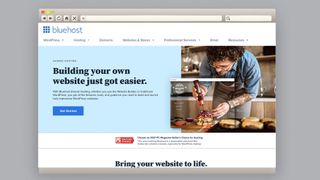
Specifications
Reasons to buy
Reasons to avoid
WordPress is website-building software that powers around a third of the web. And if you have some familiarity with it, then Bluehost is well worth considering.
Bluehost doesn’t just offer web hosting, it also offers its website builder. And what’s different from other services is that it runs on top of WordPress, which means you’re essentially editing a theme from WordPress, but within the interface of Bluehost. The bonus to this is that once you’ve built your site using the easy-to-use drag-and-drop editor, you have many options to finesse things further using one of the thousands of WordPress plugins.
On the basic plan, Bluehost’s web builder isn’t as cheap as those of rivals like Wix. But it doesn’t include ads and clunky domain names. So if you want a professional look for your site, Bluehost represents good value. Particularly if you want e-commerce features, which are available for a lot cheaper than Wix has to offer. For more, see our Bluehost web builder review.
Best AI website builder for artists

04. Hostinger
Specifications
Reasons to buy
Reasons to avoid
Much like Jimdo at number two on our list, Hostinger offers an AI-based service that allows you to effortlessly create a website in just a few clicks. It’s marginally more expensive than Jimdo, but offers a host of different value-adding services and features that could well sway you to invest just that little more.
We first reviewed Hostinger back in 2020, but it’s massively improved since then, featuring a wide array of tools to help you build a website that does your artwork justice. With integrated e-commerce functionality and analytics integrated with social media, you’ll be able to learn more about your customers and make sure you’re hitting the right mark with future projects.
The interface can also generate alt text for images, automatically produce a site map, and you get a free 12-month domain too. Get started with Hostinger for as low as £2.59/mo for a basic website and a free domain names, or opt for a higher budget of £3.79/mo per month you benefit from more AI tools and e-commerce tools, too.
See our full Hostinger review (2020)
How to choose the best website builder for artists
As an artist, your website is both your digital gallery and a window to your soul. So choosing the right platform to build it on can make all the difference in connecting with your audience. To pick the best one, we suggest prioritising platforms with attractive minimalist templates.
In terms of features, you might also want to look for high-resolution image galleries, built-in lightboxes, and options to customise your layout and presentation. If you plan to sell prints, originals, or merchandise, ensure the platform offers robust e-commerce features like secure payment gateways, inventory management, and shipping integrations.
But above all, choose a platform that matches your level of tech know-how. For example, Wix and Squarespace offer drag-and-drop simplicity, while WordPress.org requires more technical expertise.
How we test
In order to bring together our picks of the best website builders for artists, we routinely and robustly test all of the best platforms, making our own websites and taking note of the whole experience, from signing up to tweaking the site.
For artists, we’re looking for website builders with a large amount of customisability and not too much complexity in user experience, and most importantly, that will look good and promote artists’ work well. We consider what different artists may be using their sites for, whether it’s for sale, display or creating intrigue and test out the web builders with these use cases in mind.
Lastly, we factor in practical aspects; how much does this service cost, how accessible is it, is it offering good value for money; and how good is the support? We test out the support options by asking a question and seeing how quickly we get help.
Once we’ve built a site, we also look at how easy it is to tweak and maintain, as well as how simple it is to make bigger changes.
FAQs
Do you need a website as an artist?
No artist needs a website. Indeed some established artists make a healthy living through word-of-mouth and don’t have any digital presence at all. But if you don’t already have patrons funding you or commissions flowing in from existing customers, and you need to promote yourself and your art, having a website can help enormously.
Yes, you could showcase your work on a social media platform like Instagram, but people are going to take you less seriously. On your website, conversely, you can choose how your work is presented, who comments on it, and make it easy for people to find exactly what they’re looking for.
What is a website builder?
A website builder is an online service that you access via a browser, which allows you to build your own website. Most of these services are available as monthly or annual subscriptions, and will usually include hosting for your site and a domain name. Once you’ve signed up, you’ll usually gain access to an interface that allows you to craft web pages using templates and a drag-and-drop editor. Essentially, you just need to pick a template and add your own text, images, videos and so on.
What’s the best website builder for artists?
In our view, the best website builder for artists is Squarespace, because it’s specifically aimed at creatives and has the most beautiful templates. This means your work can be displayed in the best possible light, with lots of white space that allows your art to breathe. The interface is also relatively easy to use, the service is a good value (if not the cheapest on the market), and there are excellent e-commerce tools if you want to sell prints or similar items.
What should I include on my artist website?
Whether you’re seeking to attract buyers, clients or employers, the most important thing to include in your artist website is a portfolio of your work : and only your best work (see more on this below). Aside from this, you’ll probably want to include an ‘About me’ page with a brief biography so people know who you are.
You don’t necessarily have to detail your whole CV and background here. It can be more effective to mention some key highlights and add a bit of personality. Mention what makes your art different. You might also want to include a list of clients. You’ll also want to include contact details so that people can get in touch and links to your social media accounts so people can follow you and see more of your work there.
What should I include in my artist’s website’s portfolio section
We would recommend only including your best work in your online portfolio. It can be tempting to throw in everything you’ve ever done to make yourself look more prolific, but most people aren’t going to have the time and patience to scroll through a huge amount of material, and the inclusion of even a few pieces of work that aren’t you best can dilute the impact of the good pieces. If someone sees a small amount of amazing work, they tend to form a better impression of the artist than if they see the same amazing work mixed in with less impressive pieces.
This means you have to be ruthless, and pare it down your work to a minimum (unless you genuinely think all of your work is showstopping). This might even involve leaving out pieces for important clients if you’re not happy with them, although the name of a big client can also carry some weight.
Another thing to bear in mind is consistency. Sometimes an artist might want to show versatility, but clients will often be attracted to a specific style. If you have worked in several different styles, consider separating these into different sections so that each part of your portfolio looks consistent and not a mix of random work. Also think about what kind of work you actually like doing and would like to be commissioned for in the future and include this in your portfolio (and avoid showing any kinds of work you don’t want to do).
How can artists build an online store?
The easiest way for artists who don’t know code to build an online store is using Shopify. This website builder platform makes it easy to set up a website and add a shop to it. This will allow you to list products such as paintings, drawings, prints, books and more, and sell them directly to the public. You’ll be take payments from a variety of payment providers, and there are also marketing tools to help promote your work.
There are countless other features to help customise your store, including integrating it with your social media accounts. Overall, you’ll pay more than with other website builders, but the extra income may potentially more than compensate for that.
How can I protect the artwork on my website from unauthorised use?
One of the most usual ways to protect work on an artist website from unauthorised use is by adding watermarks in the form of a semi-transparent text or a logo. There are now tools that can remove some watermarks quite easily. Your watermark needs to be large enough and complex enough to at least make it difficult to remove in basic image editing software.
Another sensible option is to upload your art in relatively small sizes. This might not prevent the possibility of someone using it on social media, but it should at least mean that it’s not possible to print your work without going to the trouble of upscaling it. This also has the added advantage of faster loading times for your site.
Should I use a website builder or hire a web designer to make my artist website?
This is sometimes a question of whether you can rather than whether you show. If your budget allows it, hiring a web designer is the way to go if you want a truly unique site that stands out and is tailored to the nature of your work. However, if you’re starting out or your testing an unproven business concept, this may not be an option.
If you need a website simply to get your work out there so potential customers can see it, then a website builder should work just fine. It provides the benefit that you can do all the tweaking yourself. Squarespace, in particular, has some beautiful minimalist templates that make the artwork itself the main star of the show. Just bear in mind that other people will be using the same layouts.
